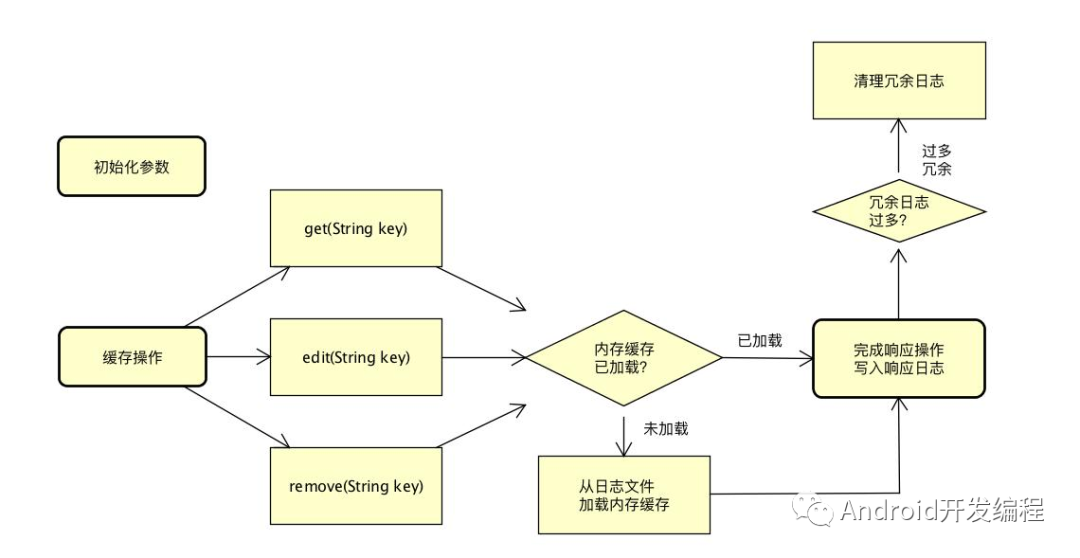DiskLruCache是一种管理数据存储的技术,单从Cache的字面意思也可以理解到,"Cache","高速缓存"。
前言
DiskLruCache是一种管理数据存储的技术,单从Cache的字面意思也可以理解到,"Cache","高速缓存";
之前我们介绍过lrucache,没有看过老铁,可以从历史记录看;
今天我们来从源码上分析下DiskLruCache;
Android进阶之彻底理解LruCache缓存机制原理
一、为什么用DiskLruCache
1、LruCache和DiskLruCache
LruCache和DiskLruCache两者都是利用到LRU算法,通过LRU算法对缓存进行管理,以最近最少使用作为管理的依据,删除最近最少使用的数据,保留最近最常用的数据;
LruCache运用于内存缓存,而DiskLruCache是存储设备缓存;
2、为何使用DiskLruCache
离线数据存在的意义,当无网络或者是网络状况不好时,APP依然具备部分功能是一种很好的用户体验;
假设网易新闻这类新闻客户端,数据完全存储在缓存中而不使用DiskLruCache技术存储,那么当客户端被销毁,缓存被释放,意味着再次打开APP将是一片空白;
另外DiskLruCache技术也可为app“离线阅读”这一功能做技术支持;
DiskLruCache的存储路径是可以自定义的,不过也可以是默认的存储路径,而默认的存储路径一般是这样的:/sdcard/Android/data/包名/cache,包名是指APP的包名。我们可以在手机上打开,浏览这一路径;
二、DiskLruCache使用
1、添加依赖
// add dependence implementation 'com.jakewharton:disklrucache:2.0.2'
2、创建DiskLruCache对象
/* * directory – 缓存目录 * appVersion - 缓存版本 * valueCount – 每个key对应value的个数 * maxSize – 缓存大小的上限 */ DiskLruCache diskLruCache = DiskLruCache.open(directory, 1, 1, 1024 * 1024 * 10);
3、添加 / 获取 缓存(一对一)
/**
* 添加一条缓存,一个key对应一个value
*/
public void addDiskCache(String key, String value) throws IOException {
File cacheDir = context.getCacheDir();
DiskLruCache diskLruCache = DiskLruCache.open(cacheDir, 1, 1, 1024 * 1024 * 10);
DiskLruCache.Editor editor = diskLruCache.edit(key);
// index与valueCount对应,分别为0,1,2...valueCount-1
editor.newOutputStream(0).write(value.getBytes());
editor.commit();
diskLruCache.close();
}
/**
* 获取一条缓存,一个key对应一个value
*/
public void getDiskCache(String key) throws IOException {
File directory = context.getCacheDir();
DiskLruCache diskLruCache = DiskLruCache.open(directory, 1, 1, 1024 * 1024 * 10);
String value = diskLruCache.get(key).getString(0);
diskLruCache.close();
}4、添加 / 获取 缓存(一对多)
/**
* 添加一条缓存,1个key对应2个value
*/
public void addDiskCache(String key, String value1, String value2) throws IOException {
File directory = context.getCacheDir();
DiskLruCache diskLruCache = DiskLruCache.open(directory, 1, 2, 1024 * 1024 * 10);
DiskLruCache.Editor editor = diskLruCache.edit(key);
editor.newOutputStream(0).write(value1.getBytes());
editor.newOutputStream(1).write(value2.getBytes());
editor.commit();
diskLruCache.close();
}
/**
* 添加一条缓存,1个key对应2个value
*/
public void getDiskCache(String key) throws IOException {
File directory = context.getCacheDir();
DiskLruCache diskLruCache = DiskLruCache.open(directory, 1, 2, 1024);
DiskLruCache.Snapshot snapshot = diskLruCache.get(key);
String value1 = snapshot.getString(0);
String value2 = snapshot.getString(1);
diskLruCache.close();
}三、源码分析
1、open()
DiskLruCache的构造方法是private修饰,这也就是告诉我们,不能通过new DiskLruCache来获取实例,构造方法如下:
private DiskLruCache(File directory, int appVersion, int valueCount, long maxSize) {
this.directory = directory;
this.appVersion = appVersion;
this.journalFile = new File(directory, JOURNAL_FILE);
this.journalFileTmp = new File(directory, JOURNAL_FILE_TEMP);
this.journalFileBackup = new File(directory, JOURNAL_FILE_BACKUP);
this.valueCount = valueCount;
this.maxSize = maxSize;
}但是提供了open()方法,供我们获取DiskLruCache的实例,open方法如下:
/**
* Opens the cache in {@code directory}, creating a cache if none exists
* there.
*
* @param directory a writable directory
* @param valueCount the number of values per cache entry. Must be positive.
* @param maxSize the maximum number of bytes this cache should use to store
* @throws IOException if reading or writing the cache directory fails
*/
public static DiskLruCache open(File directory, int appVersion, int valueCount, long maxSize)
throws IOException {
if (maxSize <= 0) {
throw new IllegalArgumentException("maxSize <= 0");
}
if (valueCount <= 0) {
throw new IllegalArgumentException("valueCount <= 0");
}
// If a bkp file exists, use it instead.
//看备份文件是否存在
File backupFile = new File(directory, JOURNAL_FILE_BACKUP);
//如果备份文件存在,并且日志文件也存在,就把备份文件删除
//如果备份文件存在,日志文件不存在,就把备份文件重命名为日志文件
if (backupFile.exists()) {
File journalFile = new File(directory, JOURNAL_FILE);
// If journal file also exists just delete backup file.
//
if (journalFile.exists()) {
backupFile.delete();
} else {
renameTo(backupFile, journalFile, false);
}
}
// Prefer to pick up where we left off.
//初始化DiskLruCache,包括,大小,版本,路径,key对应多少value
DiskLruCache cache = new DiskLruCache(directory, appVersion, valueCount, maxSize);
//如果日志文件存在,就开始赌文件信息,并返回
//主要就是构建entry列表
if (cache.journalFile.exists()) {
try {
cache.readJournal();
cache.processJournal();
return cache;
} catch (IOException journalIsCorrupt) {
System.out
.println("DiskLruCache "
+ directory
+ " is corrupt: "
+ journalIsCorrupt.getMessage()
+ ", removing");
cache.delete();
}
}
//不存在就新建一个
// Create a new empty cache.
directory.mkdirs();
cache = new DiskLruCache(directory, appVersion, valueCount, maxSize);
cache.rebuildJournal();
return cache;
}open函数:如果日志文件存在,直接去构建entry列表;如果不存在,就构建日志文件;
2、rebuildJournal()
构建文件:
//这个就是我们可以直接在disk里面看到的journal文件 主要就是对他的操作
private final File journalFile;
//journal文件的temp 缓存文件,一般都是先构建这个缓存文件,等待构建完成以后将这个缓存文件重新命名为journal
private final File journalFileTmp;
/**
* Creates a new journal that omits redundant information. This replaces the
* current journal if it exists.
*/
private synchronized void rebuildJournal() throws IOException {
if (journalWriter != null) {
journalWriter.close();
}
//指向journalFileTmp这个日志文件的缓存
Writer writer = new BufferedWriter(
new OutputStreamWriter(new FileOutputStream(journalFileTmp), Util.US_ASCII));
try {
writer.write(MAGIC);
writer.write("\n");
writer.write(VERSION_1);
writer.write("\n");
writer.write(Integer.toString(appVersion));
writer.write("\n");
writer.write(Integer.toString(valueCount));
writer.write("\n");
writer.write("\n");
for (Entry entry : lruEntries.values()) {
if (entry.currentEditor != null) {
writer.write(DIRTY + ' ' + entry.key + '\n');
} else {
writer.write(CLEAN + ' ' + entry.key + entry.getLengths() + '\n');
}
}
} finally {
writer.close();
}
if (journalFile.exists()) {
renameTo(journalFile, journalFileBackup, true);
}
//所以这个地方 构建日志文件的流程主要就是先构建出日志文件的缓存文件,如果缓存构建成功 那就直接重命名这个缓存文件,这样做好处在哪里?
renameTo(journalFileTmp, journalFile, false);
journalFileBackup.delete();
//这里也是把写入日志文件的writer初始化
journalWriter = new BufferedWriter(
new OutputStreamWriter(new FileOutputStream(journalFile, true), Util.US_ASCII));
}再来看当日志文件存在的时候,做了什么
3、readJournal()
private void readJournal() throws IOException {
StrictLineReader reader = new StrictLineReader(new FileInputStream(journalFile), Util.US_ASCII);
try {
//读日志文件的头信息
String magic = reader.readLine();
String version = reader.readLine();
String appVersionString = reader.readLine();
String valueCountString = reader.readLine();
String blank = reader.readLine();
if (!MAGIC.equals(magic)
|| !VERSION_1.equals(version)
|| !Integer.toString(appVersion).equals(appVersionString)
|| !Integer.toString(valueCount).equals(valueCountString)
|| !"".equals(blank)) {
throw new IOException("unexpected journal header: [" + magic + ", " + version + ", "
+ valueCountString + ", " + blank + "]");
}
//这里开始,就开始读取日志信息
int lineCount = 0;
while (true) {
try {
//构建LruEntries entry列表
readJournalLine(reader.readLine());
lineCount++;
} catch (EOFException endOfJournal) {
break;
}
}
redundantOpCount = lineCount - lruEntries.size();
// If we ended on a truncated line, rebuild the journal before appending to it.
if (reader.hasUnterminatedLine()) {
rebuildJournal();
} else {
//初始化写入文件的writer
journalWriter = new BufferedWriter(new OutputStreamWriter(
new FileOutputStream(journalFile, true), Util.US_ASCII));
}
} finally {
Util.closeQuietly(reader);
}
}然后看下这个函数里面的几个主要变量:
//每个entry对应的缓存文件的格式 一般为1,也就是一个key,对应几个缓存,一般设为1,key-value一一对应的关系 private final int valueCount; private long size = 0; //这个是专门用于写入日志文件的writer private Writer journalWriter; //这个集合应该不陌生了, private final LinkedHashMap<String, Entry> lruEntries = new LinkedHashMap<String, Entry>(0, 0.75f, true); //这个值大于一定数目时 就会触发对journal文件的清理了 private int redundantOpCount;
下面就看下entry这个实体类的内部结构
private final class Entry {
private final String key;
/**
* Lengths of this entry's files.
* 这个entry中 每个文件的长度,这个数组的长度为valueCount 一般都是1
*/
private final long[] lengths;
/**
* True if this entry has ever been published.
* 曾经被发布过 那他的值就是true
*/
private boolean readable;
/**
* The ongoing edit or null if this entry is not being edited.
* 这个entry对应的editor
*/
private Editor currentEditor;
@Override
public String toString() {
return "Entry{" +
"key='" + key + '\'' +
", lengths=" + Arrays.toString(lengths) +
", readable=" + readable +
", currentEditor=" + currentEditor +
", sequenceNumber=" + sequenceNumber +
'}';
}
/**
* The sequence number of the most recently committed edit to this entry.
* 最近编辑他的序列号
*/
private long sequenceNumber;
private Entry(String key) {
this.key = key;
this.lengths = new long[valueCount];
}
public String getLengths() throws IOException {
StringBuilder result = new StringBuilder();
for (long size : lengths) {
result.append(' ').append(size);
}
return result.toString();
}
/**
* Set lengths using decimal numbers like "10123".
*/
private void setLengths(String[] strings) throws IOException {
if (strings.length != valueCount) {
throw invalidLengths(strings);
}
try {
for (int i = 0; i < strings.length; i++) {
lengths[i] = Long.parseLong(s
相关推荐





0评论